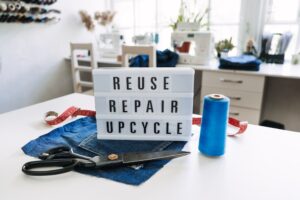Fashion has come a long way in recent years, with consumers becoming more aware of the environmental and social impact of their purchasing decisions. While fast fashion has long dominated the industry, there’s a growing movement towards sustainable and ethical fashion, and Bernardo Fashions is at the forefront of this change.
Bernardo Fashions has been making a difference in the fashion industry with a mission to create stylish and sustainable outerwear since 1966. From recycled materials to ethical labor practices, this company is redefining what it means to be a sustainable and ethical fashion brand.
Commitment to Sustainability
At the core of Bernardo Fashions’ mission is a commitment to sustainability. The company has a range of sustainable collections, including Full Circle and Eco-Minded, which use recycled materials and eco-friendly manufacturing practices to create stylish outerwear.
One of the standout sustainable materials used by Bernardo Fashions is Ecoplume™. This is 100% recycled insulation made from post-consumer plastic bottles that provides superior warmth and comfort. In addition, the company uses bluesign® certified fabrics and processes, ensuring that their products are made with the highest environmental standards.
Ethical Manufacturing Practices
Bernardo Fashions is also committed to ethical manufacturing practices, ensuring that their products are made in safe and fair working conditions. The company has a Code of Conduct that outlines their commitment to social responsibility, and they require all their suppliers to adhere to these standards as well.
Bernardo Fashions also partners with factories that are WRAP (Worldwide Responsible Accredited Production) certified. This certification ensures that the factories meet rigorous ethical and environmental standards, including fair labor practices and responsible use of resources.
Circular Fashion
Bernardo Fashions is also committed to circular fashion, which aims to create a closed-loop system where resources are reused, and waste is minimized. The company has an EcoLoved program where customers can send in their gently used outerwear for recycling or resale. In exchange, customers receive Bernardo shopping credit, creating a closed-loop system where products are reused instead of discarded.
Stylish and Functional Design
Of course, sustainability and ethics aren’t the only considerations when it comes to fashion. Bernardo Fashions also creates stylish and functional outerwear that meets the needs of modern consumers. From puffer jackets to wool coats, the company has a range of fashionable and practical designs.
What’s more, the company is constantly innovating and improving their products. For example, their Ecoplume™ insulation has been updated with new technology that makes it even more sustainable and high-performing.
Making a Real Difference
Ultimately, what sets Bernardo Fashions apart is their commitment to making a real difference in the fashion industry. From their sustainable materials to their ethical manufacturing practices, they are setting a new standard for being a sustainable and ethical fashion brand.
And it’s not just talk – the company’s impact speaks for itself. Bernardo Fashions has recirculated 5.6K items and avoided 106K miles of driving emissions through their EcoLoved program. What’s more, they have saved 434K gallons of drinking water through their use of sustainable materials and practices.
Final Thoughts
Bernardo Fashions is a company that is redefining sustainable and ethical fashion. Their commitment to sustainability and ethics is clear, and their impact makes a real difference in the fashion industry. If you’re looking for stylish and sustainable outerwear, look no further than Bernardo Fashions.
Related Topic:
Closing the Loop: How Circular Fashion is Revolutionizing the Industry and Redefining Sustainability as the New Trend
The fashion industry has traditionally been characterized by a linear model, where clothes are produced, sold, and disposed of, often within a short period. This model has significant negative impacts on the environment, from resource depletion to waste generation and pollution. However, a new trend is emerging in the fashion industry: circular fashion. In this blog post, we will explore what circular fashion is, its benefits, and how it is revolutionizing the industry while redefining sustainability as the new trend.
What is Circular Fashion?
Circular fashion is an alternative model to the traditional linear fashion model. Rather than following a “take-make-dispose” approach, circular fashion aims to create a closed-loop system that reduces waste and maximizes the lifespan of clothing. This is done by designing clothes for durability, recycling and reusing materials, and reducing waste throughout the supply chain. Circular fashion is based on three main principles: reduce, reuse, and recycle.
The Impact of Linear Fashion on the Environment
The traditional linear fashion model has significant negative impacts on the environment. Fast fashion, characterized by producing large quantities of low-cost clothing, has led to the overconsumption of resources such as water, energy, and raw materials. Additionally, the high turnover of clothes in this model generates a huge amount of waste that ends up in landfills, contributing to pollution and greenhouse gas emissions.
The Rise of Circular Fashion
The rise of circular fashion is driven by a growing awareness of the negative environmental impacts of the traditional fashion industry. Circular fashion offers a more sustainable and responsible way of producing and consuming clothing and has numerous benefits. For example, circular fashion reduces waste and pollution, extends the lifespan of products, and conserves resources.
Circular Fashion Initiatives
Many examples of circular fashion initiatives are emerging in the industry. One example is “closed-loop” systems, where materials are recycled and reused to create new products. Companies also invest in innovative technologies that reduce waste and conserve resources, such as using biodegradable and organic materials or creating clothes that can be easily repaired and repurposed. Additionally, circular fashion is driving new business models and collaborations, such as rental and sharing services, which encourage using clothes for longer periods.
How Circular Fashion is Revolutionizing the Industry
Circular fashion is revolutionizing the industry by challenging the traditional linear model and promoting sustainable practices. Innovations in material design and production are creating more sustainable materials that are better for the environment. New business models, such as rental and subscription services, are emerging, reducing resource consumption while providing new revenue streams for fashion brands. Finally, consumer education and engagement drive a new level of awareness and accountability, encouraging people to demand more sustainable fashion options and supporting circular practices.
Redefining Sustainability as the New Trend
Circular fashion is redefining sustainability as the new trend, and consumer attitudes towards sustainability are changing as a result. Social media and influencers are playing a significant role in this shift, as they are helping to create a culture of sustainability that is cool, trendy, and desirable. As more people become aware of the benefits of circular fashion, it will likely become more mainstream, and sustainability will become a defining characteristic of the fashion industry.
Final Thoughts
Circular fashion is revolutionizing the industry by promoting sustainable practices that reduce waste and maximize the lifespan of clothing. By redefining sustainability as the new trend, circular fashion changes consumer attitudes towards fashion and drives new business models and collaborations. However, there is still a long way to go to fully transition the fashion industry to a circular model, and we all have a role in making this shift happen. As consumers, we can demand more sustainable options and support brands prioritizing circular practices.
We can also reduce our own consumption and opt for pre-loved or secondhand clothing. As an industry, we must invest in sustainable technologies and business models and prioritize circularity in all aspects of the supply chain.
Circular fashion is not just a trend but a necessary shift towards a more sustainable and responsible way of producing and consuming clothing. By adopting circular practices, we can reduce waste, conserve resources, and create a more equitable and sustainable future for all.












Reader Interactions